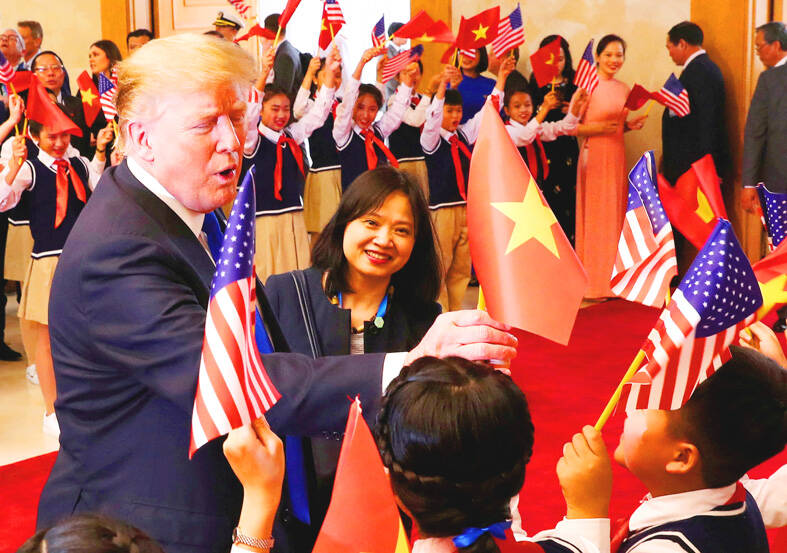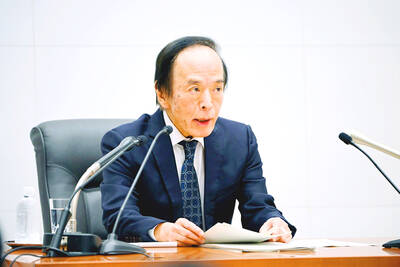Vietnamese and US companies have signed more than US$4 billion in deals, a petrochemical giant said yesterday, as anxiety mounts in Hanoi over potential tariffs under the administration of US President Donald Trump.
The Southeast Asian nation has the third-biggest trade surplus with the US, after China and Mexico — both targeted by Trump since he took office.
A statement posted by PetroVietnam Power Corp (PVPower) on its Web site said the new projects — in areas such as aviation, oil and gas exploration, and petrochemical imports — were worth about US$4.15 billion.

Photo: Reuters
The “highly meaningful” deals were aimed at establishing “balanced and harmonious” trade, and would create hundreds of thousands of jobs for workers in the two nations, PVPower said.
They were signed in the US on Thursday during a visit by Vietnamese Minister of Industry and Trade Nguyen Hong Dien to meet US Trade Representative Jamieson Greer in Washington.
Greer told Dien that Vietnam “needs to have stronger solutions to open the market and improve the trade balance,” according to a report on the Web site of the Vietnamese Ministry of Industry and Trade.
There is increasing worry in Hanoi that Vietnam could be the next target of Trump’s tariffs, which have sent shock waves through global markets.
Earlier, Hanoi said it was reviewing import duties on goods from the US. Vietnamese Prime Minister Pham Minh Chinh told US Ambassador Marc Knapper that the review would look to encourage increased imports of liquified natural gas, as well as agricultural and high-tech products, a report on the government’s Web site said on Thursday.
Chinh told Knapper that Vietnam was “actively addressing the current concerns of the US in economic-trade-investment relations.”
Vietnam was also “reviewing import tariffs on goods from the United States, encouraging increased imports of key US products that Vietnam needs, especially agricultural products, liquefied gas and high-tech products,” the report said.
The US trade deficit in goods with Vietnam was US$123.5 billion last year, up more than 18 percent on 2023, according to the Office of the US Trade Representative.

Taiwan Semiconductor Manufacturing Co (TSMC, 台積電) last week recorded an increase in the number of shareholders to the highest in almost eight months, despite its share price falling 3.38 percent from the previous week, Taiwan Stock Exchange data released on Saturday showed. As of Friday, TSMC had 1.88 million shareholders, the most since the week of April 25 and an increase of 31,870 from the previous week, the data showed. The number of shareholders jumped despite a drop of NT$50 (US$1.59), or 3.38 percent, in TSMC’s share price from a week earlier to NT$1,430, as investors took profits from their earlier gains

In a high-security Shenzhen laboratory, Chinese scientists have built what Washington has spent years trying to prevent: a prototype of a machine capable of producing the cutting-edge semiconductor chips that power artificial intelligence (AI), smartphones and weapons central to Western military dominance, Reuters has learned. Completed early this year and undergoing testing, the prototype fills nearly an entire factory floor. It was built by a team of former engineers from Dutch semiconductor giant ASML who reverse-engineered the company’s extreme ultraviolet lithography (EUV) machines, according to two people with knowledge of the project. EUV machines sit at the heart of a technological Cold

TAIWAN VALUE CHAIN: Foxtron is to fully own Luxgen following the transaction and it plans to launch a new electric model, the Foxtron Bria, in Taiwan next year Yulon Motor Co (裕隆汽車) yesterday said that its board of directors approved the disposal of its electric vehicle (EV) unit, Luxgen Motor Co (納智捷汽車), to Foxtron Vehicle Technologies Co (鴻華先進) for NT$787.6 million (US$24.98 million). Foxtron, a half-half joint venture between Yulon affiliate Hua-Chuang Automobile Information Technical Center Co (華創車電) and Hon Hai Precision Industry Co (鴻海精密), expects to wrap up the deal in the first quarter of next year. Foxtron would fully own Luxgen following the transaction, including five car distributing companies, outlets and all employees. The deal is subject to the approval of the Fair Trade Commission, Foxtron said. “Foxtron will be

INFLATION CONSIDERATION: The BOJ governor said that it would ‘keep making appropriate decisions’ and would adjust depending on the economy and prices The Bank of Japan (BOJ) yesterday raised its benchmark interest rate to the highest in 30 years and said more increases are in the pipeline if conditions allow, in a sign of growing conviction that it can attain the stable inflation target it has pursued for more than a decade. Bank of Japan Governor Kazuo Ueda’s policy board increased the rate by 0.2 percentage points to 0.75 percent, in a unanimous decision, the bank said in a statement. The central bank cited the rising likelihood of its economic outlook being realized. The rate change was expected by all 50 economists surveyed by Bloomberg. The